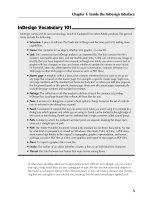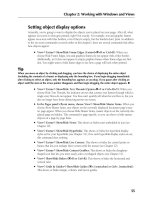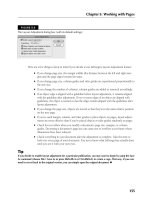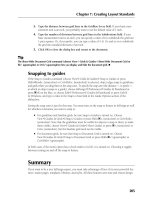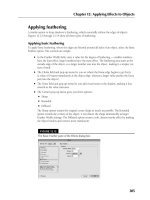Adobe InDesign CS5 Bible potx
Bạn đang xem bản rút gọn của tài liệu. Xem và tải ngay bản đầy đủ của tài liệu tại đây (14.64 MB, 939 trang )
Make a bigger impact
with better designs
Create animations and
interactive documents
Learn new CS5 tools
and techniques
Gruman
The book you need to succeed!
Push the limits of InDesign
with this in-depth guide
Whether you want to produce eye-catching ads, flashy
newsletters, or interactive PDFs, this detailed guide
shows you how to do it using InDesign CS5. No
matter what your level of experience, everything you
need is right here. From thorough coverage of new
CS5 features, to tricks and techniques from publishing
pros, to how to create winning client presentations—
if you want to master InDesign, this is the book you
need to succeed!
Companion Web Site
• Work efficiently with layers, master pages, and multiple page sizes
• Create text and graphics frames and add metadata captions
• Place objects where you want them with smart tools
• Build timelines and animation, or embed movies and sound
• Create client presentations, work in groups, and collaborate over the Web
• Edit Photoshop
®
, Illustrator
®
, and PDF files from within InDesign
Companion
Web Site
Visit www.indesigncentral.com
for additional tools, updates,
resources, tips, and more.
Galen Gruman
is principal at The Zango Group and
a veteran desktop-publishing guru.
A frequent contributor to
Macworld,
CIO
,
InfoWorld
and other publications,
he has also been editor of
Macworld
, West Coast bureau chief
of
Computerworld
, and executive
editor of InfoWorld.com. He is the
author of
Adobe InDesign CS4
and coauthor of 22 other books
on desktop publishing.
Shelving Category:
COMPUTERS / Image Processing
Reader Level:
Beginning to Advanced
$49.99 USA
$59.99 Canada
Companion Web Site
• Additional tools, updates, resources,
and more
Adobe
®
InDesign
®
CS5
Quickly select overlapped
objects with the content
grabber
Set headline text to span
multiple columns
Adjust object’s relative size
using the Gap tool
Galen Gruman
InDesign
®
CS5
Adobe
®
8-Page Color Insert!
• Striking, full-color examples show
you what you can achieve
www.it-ebooks.info
01_607169-ffirs.indd ii01_607169-ffirs.indd ii 4/22/10 7:37 PM4/22/10 7:37 PM
www.it-ebooks.info
Adobe
®
InDesign
®
CS5
Bible
01_607169-ffirs.indd i01_607169-ffirs.indd i 4/22/10 7:37 PM4/22/10 7:37 PM
www.it-ebooks.info
01_607169-ffirs.indd ii01_607169-ffirs.indd ii 4/22/10 7:37 PM4/22/10 7:37 PM
www.it-ebooks.info
Adobe
®
InDesign
®
CS5
Bible
Galen Gruman
01_607169-ffirs.indd iii01_607169-ffirs.indd iii 4/22/10 7:37 PM4/22/10 7:37 PM
www.it-ebooks.info
Adobe
®
InDesign
®
CS5 Bible
Published by
Wiley Publishing, Inc.
10475 Crosspoint Boulevard
Indianapolis, IN 46256
www.wiley.com
Copyright © 2010 by Wiley Publishing, Inc., Indianapolis, Indiana
Published by Wiley Publishing, Inc., Indianapolis, Indiana
Published simultaneously in Canada
ISBN: 978-0-470-60716-9
Manufactured in the United States of America
10 9 8 7 6 5 4 3 2 1
No part of this publication may be reproduced, stored in a retrieval system or transmitted in any form or
by any means, electronic, mechanical, photocopying, recording, scanning or otherwise, except as per-
mitted under Sections 107 or 108 of the 1976 United States Copyright Act, without either the prior
written permission of the Publisher, or authorization through payment of the appropriate per-copy fee
to the Copyright Clearance Center, 222 Rosewood Drive, Danvers, MA 01923, (978) 750-8400, fax
(978) 646-8600. Requests to the Publisher for permission should be addressed to the Permissions
Department, John Wiley & Sons, Inc., 111 River Street, Hoboken, NJ 07030, 201-748-6011, fax 201-
748-6008, or online at />LIMIT OF LIABILITY/DISCLAIMER OF WARRANTY: THE PUBLISHER AND THE AUTHOR MAKE NO
REPRESENTATIONS OR WARRANTIES WITH RESPECT TO THE ACCURACY OR COMPLETENESS OF THE
CONTENTS OF THIS WORK AND SPECIFICALLY DISCLAIM ALL WARRANTIES, INCLUDING WITHOUT
LIMITATION WARRANTIES OF FITNESS FOR A PARTICULAR PURPOSE. NO WARRANTY MAY BE CREATED
OR EXTENDED BY SALES OR PROMOTIONAL MATERIALS. THE ADVICE AND STRATEGIES CONTAINED
HEREIN MAY NOT BE SUITABLE FOR EVERY SITUATION. THIS WORK IS SOLD WITH THE UNDERSTANDING
THAT THE PUBLISHER IS NOT ENGAGED IN RENDERING LEGAL, ACCOUNTING, OR OTHER PROFESSIONAL
SERVICES. IF PROFESSIONAL ASSISTANCE IS REQUIRED, THE SERVICES OF A COMPETENT PROFESSIONAL
PERSON SHOULD BE SOUGHT. NEITHER THE PUBLISHER NOR THE AUTHOR SHALL BE LIABLE FOR
DAMAGES ARISING HEREFROM. THE FACT THAT AN ORGANIZATION OR WEBSITE IS REFERRED TO IN
THIS WORK AS A CITATION AND/OR A POTENTIAL SOURCE OF FURTHER INFORMATION DOES NOT MEAN
THAT THE AUTHOR OR THE PUBLISHER ENDORSES THE INFORMATION THE ORGANIZATION OR WEBSITE
MAY PROVIDE OR RECOMMENDATIONS IT MAY MAKE. FURTHER, READERS SHOULD BE AWARE THAT
INTERNET WEBSITES LISTED IN THIS WORK MAY HAVE CHANGED OR DISAPPEARED BETWEEN WHEN
THIS WORK WAS WRITTEN AND WHEN IT IS READ.
For general information on our other products and services or to obtain technical support, please contact our Customer
Care Department within the U.S. at (877) 762-2974, outside the U.S. at (317) 572-3993 or fax (317) 572-4002.
Library of Congress Control Number: 2010926829
Trademarks: Wiley and related trade dress are registered trademarks of Wiley Publishing, Inc., in the United States and
other countries, and may not be used without written permission. All other trademarks are the property of their respective
owners. Wiley Publishing, Inc., is not associated with any product or vendor mentioned in this book.
Wiley also publishes its books in a variety of electronic formats. Some content that appears in print may not be available in
electronic books.
01_607169-ffirs.indd iv01_607169-ffirs.indd iv 4/22/10 7:37 PM4/22/10 7:37 PM
www.it-ebooks.info
About the Author
Galen Gruman is the principal at The Zango Group, an editorial development and book produc-
tion firm. As such, he has produced multiple books for Wiley Publishing. He is author or coauthor
of 24 other books on desktop publishing, as well as coauthor of the Mac OS X Snow Leopard Bible.
Gruman led one of the first successful conversions of a national magazine to desktop publishing in
1986 and has covered publishing technology since then for several publications, including Layers
Magazine; Macworld, whose staff he was a member of from 1991 to 1998; and InfoWorld, for which
he began writing in 1986 and of which he is now executive editor.
01_607169-ffirs.indd v01_607169-ffirs.indd v 4/22/10 7:37 PM4/22/10 7:37 PM
www.it-ebooks.info
Credits
Acquisitions Editor
Aaron Black
Project Editor
Chris Wolfgang
Technical Editor
Jonathan Woolson
Copy Editor
Scott Tullis
Editorial Director
Robyn Siesky
Editorial Manager
Cricket Krengel
Business Manager
Amy Knies
Senior Marketing Manager
Sandy Smith
Vice President and Executive Group
Publisher
Richard Swadley
Vice President and Executive Publisher
Barry Pruett
Project Coordinator
Patrick Redmond
Graphics and Production Specialists
Andrea Hornberger
Jennifer Mayberry
Quality Control Technician
Melissa Cossell
Proofreading and Indexing
Christine Sabooni
Word Co Indexing Services
Media Development Project Manager
Laura Moss
Media Development Assistant Project Manager
Jenny Swisher
Media Development Associate Producer
Josh Frank
Shawn Patrick
Doug Kuhn
Marilyn Hummel
To my wonderful extended family for their ongoing support
and encouragement: my partner Ingall; my mother Leah;
my in-laws the Bulls, Belskys, and Hills; and my brothers
Darius and Stephen
01_607169-ffirs.indd vi01_607169-ffirs.indd vi 4/22/10 7:37 PM4/22/10 7:37 PM
www.it-ebooks.info
vii
A
fter seven versions of InDesign, you have to wonder what more can Adobe do to improve it
in meaningful ways. In the case of InDesign CS5 — the eighth version of the leading desk-
top publishing program — Adobe came up with two directions for major improvement.
One is reworking the selection and object-manipulation tools to make them more straightforward
to use while also more flexible and powerful. Such changes are felt in many places, from the Layers
and Links panels to the basic Selection and Direct Selection tools, as well as in the controls over
frame fitting, object styles, step-and-repeat, page controls, and in the new multiple-page-size, text
column-spanning, and Gap tool features.
The other major change is moving InDesign further into the realm of nonprint publishing, in this
edition through the addition of major new animation capabilities that let you create interactive
Adobe SWF files from InDesign. Plus there are a raft of improvements relating to hyperlinks, inter-
active buttons, use of media files such as video and sounds, and PDF file creation.
If you don’t work on nonprint documents, I think you’ll find the selection and object-manipulation
changes more than sufficient reason to move to InDesign CS5. But I also urge you to become famil-
iar with the creation of nonprint documents — in this electronic world, information will be pub-
lished in all sorts of ways, and sticking with just one medium is a path to obsolescence. That’s why
this book gives more weight to nonprint document tools than past editions have, and why
InDesign’s designers are steadily adding such capabilities. Use them.
These two major movements (improving object manipulation and delving further into the nonprint
publishing) have led to dozens of functionality additions and capability improvements (check out
Appendix B for the whole list) that are well designed and manage not to get in the way of all the
other features you know and love — a real challenge for a program as complex and feature-rich as
InDesign.
But of course, there are lots of other refinements in InDesign CS5 that Adobe’s engineers and
designers were able to add in beyond the major new areas of improvement. For example,
Windows 7 users will now find that InDesign supports the gestures enabled by the new genera-
tion of touchscreen PCs (Mac users got this capability in InDesign CS4). InDesign users can now
work with tracked changes in their layouts, no longer seeing this ability limited to InCopy users.
And plug-ins, renamed extensions, are now managed across all Creative Suite applications with a
common tool, the Extension Manager. These three examples show the range of areas where
Adobe has made improvements.
Layout artists have an incredibly powerful tool in the form of InDesign to let them deliver on their
creative aspirations and vision. I hope that this book helps you achieve and indeed increase those
ambitions.
02_607169-fpref.indd vii02_607169-fpref.indd vii 4/22/10 7:37 PM4/22/10 7:37 PM
www.it-ebooks.info
02_607169-fpref.indd viii02_607169-fpref.indd viii 4/22/10 7:37 PM4/22/10 7:37 PM
www.it-ebooks.info
ix
T
hanks to the development and product marketing staff at Adobe for providing early ver-
sions of the InDesign CS5 software, providing insights into their thinking as they brought
in new features, and listening to suggestions on making it even better. Thanks to the edi-
tors and production staff at Wiley Publishing for their efforts in making this book possible and a
better product, especially to acquisitions editor Aaron Black and project editor Chris Wolfgang.
And ongoing kudos to my regular technical editor Jonathan Woolson for his improvements to the
book’s accuracy and insights.
The
www.InDesignCentral.com Web site and its contents are copyrighted by The Zango Group.
Original photographs are copyrighted by Ingall W. Bull III.
03_607169-fbetw.indd ix03_607169-fbetw.indd ix 4/22/10 7:38 PM4/22/10 7:38 PM
www.it-ebooks.info
x
Preface vii
Acknowledgments ix
Introduction xxxvii
Part I: Welcome to InDesign . . . . . . . . . . . . . . . . . . . . . . . . . .1
Chapter 1: Inside the InDesign Interface 3
Chapter 2: Working with Windows and Views 45
Chapter 3: Setting InDesign Preferences 59
Part II: Document Fundamentals . . . . . . . . . . . . . . . . . . . . . 109
Chapter 4: Creating, Opening, and Saving Documents 111
Chapter 5: Working with Pages 135
Chapter 6: Working with Layers 157
Chapter 7: Creating Layout Standards 171
Chapter 8: Defining Colors, Tints, and Gradients 207
Part III: Object Fundamentals . . . . . . . . . . . . . . . . . . . . . . . 237
Chapter 9: Adding Frames, Shapes, and Lines 239
Chapter 10: Manipulating Objects 249
Chapter 11: Transforming Objects 273
Chapter 12: Applying Effects to Objects 287
Chapter 13: Orchestrating Objects 313
Part IV: Graphics Fundamentals . . . . . . . . . . . . . . . . . . . . . . 355
Chapter 14: Importing Graphics 357
Chapter 15: Fitting Graphics and Frames Together 381
Chapter 16: Drawing Free-form Shapes and Curved Paths 391
Part V: Text Fundamentals . . . . . . . . . . . . . . . . . . . . . . . . . . 421
Chapter 17: Importing Text Files 423
Chapter 18: Flowing Text through a Document 443
Chapter 19: Editing, Spell-checking, and Replacing Text 519
Chapter 20: Specifying Character Attributes 487
Chapter 21: Specifying Paragraph Attributes 509
Chapter 22: Creating Special Text Formatting 537
Chapter 23: Using Special Characters 553
04_607169-ftoc.indd x04_607169-ftoc.indd x 4/22/10 7:38 PM4/22/10 7:38 PM
www.it-ebooks.info
Part VI: Business Document Fundamentals . . . . . . . . . . . . . 571
Chapter 24: Workgroup Editing 573
Chapter 25: Setting Up Tabs and Tables 587
Chapter 26: Using Automatic and Custom Text 607
Chapter 27: Working with Footnotes, Indexes, and TOCs 627
Part VII: Output Fundamentals . . . . . . . . . . . . . . . . . . . . . . 645
Chapter 28: Creating Multidocument Projects 647
Chapter 29: Preparing for Color Prepress 657
Chapter 30: Preparing for Printing 677
Chapter 31: Printing Documents 697
Part VIII: Multimedia Fundamentals . . . . . . . . . . . . . . . . . . . 721
Chapter 32: Creating Prepress Files 723
Chapter 33: Using Hyperlinks and Creating Web Pages 743
Chapter 34: Using Interactive Media and Creating PDF Documents 759
Chapter 35: Using Animation and Creating Flash Documents 779
Part IX: Programming InDesign . . . . . . . . . . . . . . . . . . . . . . 795
Chapter 36: Working with XML 797
Chapter 37: Using Scripts 809
Part X: Appendixes . . . . . . . . . . . . . . . . . . . . . . . . . . . . . . . . 827
Appendix A: Installing InDesign and Extensions 829
Appendix B: What’s New in InDesign CS5 837
Index 851
xi
04_607169-ftoc.indd xi04_607169-ftoc.indd xi 4/22/10 7:38 PM4/22/10 7:38 PM
www.it-ebooks.info
04_607169-ftoc.indd xii04_607169-ftoc.indd xii 4/22/10 7:38 PM4/22/10 7:38 PM
www.it-ebooks.info
xiii
Preface...................................................vii
Acknowledgments ..........................................ix
Introduction ............................................xxxvii
Part I: Welcome to InDesign 1
Chapter 1: Inside the InDesign Interface..........................3
Understanding Global and Local Control 4
Exploring the InDesign Application Folder 6
The Presets folder 6
The Plug-ins folder 7
The Scripts folder 7
Exploring the Document Window 7
Title tab 9
Rulers 9
Zero point 10
Scroll bars 11
Pasteboard, pages, and guides 12
Page controls 12
Reveal pop-up menu 13
Application frame 13
Application bar 13
Using Tools 14
Selecting tools 15
Understanding what the tools do 16
Selection tool 16
Direct Selection tool 17
Page tool 19
Gap tool 19
Type tool 19
Type on a Path tool 19
Line tool 19
Pen tool 19
Anchor and direction point tools 20
04_607169-ftoc.indd xiii04_607169-ftoc.indd xiii 4/22/10 7:38 PM4/22/10 7:38 PM
www.it-ebooks.info
Contents
Pencil tool 20
Smooth tool 20
Erase tool 20
Frame tools 20
Shape tools 21
Scissors tool 21
Free Transform tool 21
Rotate tool 21
Scale tool 21
Shear tool 22
Gradient Swatch tool 22
Gradient Feather tool 22
Note tool 23
Eyedropper tool 23
Measure tool 23
Hand tool 23
Zoom tool 23
Apply buttons 23
Screen Mode buttons 23
Using tool tips and keyboard shortcuts 24
Opening and closing the Tools panel 25
Working with Panels and Docks 26
Arranging panels 27
Changing the dock display 28
Using panels 29
Checking out the panels 30
Basic control panels 30
Text-formatting panels 32
Table-formatting panels 33
Text-management panels 33
Object management panels 34
Layout management panels 34
Color management panels 35
Prepress and output management panels 35
Web and interactive media management panels 36
Automation panels 36
Specialty information panels 37
CS Live panels 37
Reviewing Menu Commands 38
InDesign menu 38
File menu 39
Edit menu 39
Layout menu 39
Type menu 40
xiv
04_607169-ftoc.indd xiv04_607169-ftoc.indd xiv 4/22/10 7:38 PM4/22/10 7:38 PM
www.it-ebooks.info
xv
Contents
Object menu 40
Table menu 40
View menu 40
Window menu 41
Help menu 41
Contextual menus 41
Undoing What You’ve Just Done 43
Summary 44
Chapter 2: Working with Windows and Views..................... 45
Working with Multiple Document Windows 45
Using Workspaces 49
Working with Views 50
Zooming and scrolling 51
The Zoom tool 51
Zoom options in the View menu 52
The Zoom Level field and pop-up menu 53
The Hand tool 53
Gestures 53
The quick zoom function 54
Setting object display options 55
Using screen modes 56
Summary 57
Chapter 3: Setting InDesign Preferences......................... 59
Working with Preferences Files 59
Setting universal defaults 59
InDesign Defaults file 60
Presets folder 61
Using the Preferences Dialog Box 62
General preferences 63
Page Numbering area 63
Font Downloading and Embedding area 64
Object Editing area 64
Reset All Warning Dialogs button 65
Interface preferences 65
Type preferences 67
Type Options area 67
Drag and Drop Text Editing area 69
Smart Text Reflow area 69
Advanced Type preferences 70
Character Settings area 70
Input Method Options area 71
Composition preferences 71
Highlight area 72
Text Wrap area 73
04_607169-ftoc.indd xv04_607169-ftoc.indd xv 4/22/10 7:38 PM4/22/10 7:38 PM
www.it-ebooks.info
xvi
Contents
Units & Increments preferences 73
Ruler Units area 73
Other Units area 75
Point/Pica Size area 76
Keyboard Increments area 76
Grids preferences 78
Baseline Grid area 78
Document Grid area 79
Guides & Pasteboard preferences 80
Color area 80
Guide Options area 80
Smart Guides area 81
Pasteboard Options area 81
Dictionary preferences 81
Language area 82
Hyphenation Exceptions area 83
User Dictionary area 84
Spelling preferences 84
Find area 85
Dynamic Spelling area 85
Autocorrect preferences 85
Notes preferences 86
Track Changes preferences 87
Story Editor Display preferences 88
Text Display Options area 88
Cursor Options area 89
Display Performance preferences 90
Options area 90
Adjust View Settings area 91
Appearance of Black preferences 91
Options for Black on RGB and Grayscale Devices area 91
Overprinting of [Black] area 92
File Handling preferences 92
Document Recovery Data area 92
Saving InDesign Files area 93
Snippet Import area 94
Links area 94
Clipboard Handling preferences 94
Clipboard area 95
When Pasting Text and Tables from Other Applications area 96
Setting Other Global Preferences 96
Setting up automatic program updates 96
Customizing keyboard shortcuts 98
Using and modifying default shortcuts 98
Viewing and printing shortcuts 100
04_607169-ftoc.indd xvi04_607169-ftoc.indd xvi 4/22/10 7:38 PM4/22/10 7:38 PM
www.it-ebooks.info
xvii
Contents
Customizing menus 101
Color management settings 102
Modifying Defaults for Documents, Text, and Objects 102
Document defaults 103
Text defaults 104
Object defaults 104
Modifying Defaults for Views 105
Setting Color and Style Defaults 106
Reverting Preferences and Defaults 107
Summary 107
Part II: Document Fundamentals 109
Chapter 4: Creating, Opening, and Saving Documents............. 111
Taking Stock before You Begin 111
Setting Up a New Publication 112
Creating new documents 113
Creating your own document types 116
Opening Documents and Templates 117
Opening documents versus opening templates 120
Working with files in the Bridge file system 121
Converting documents created with other programs 122
QuarkXPress 123
PageMaker 124
Recovering a document after a crash or power failure 124
Saving Documents and Templates 125
Saving documents versus saving templates 127
Knowing how to not save changes 127
Saving Files in Other Formats 128
Export formats for whole documents 128
Export formats for document elements 129
Working with exported tagged text files 130
Exporting files as JPEG graphics 131
Summary 133
Chapter 5: Working with Pages ............................... 135
Working with Multipage Documents 135
Adding pages 136
Changing pages’ sizes 138
Deleting pages 139
Copying and moving pages 139
Working within a document 139
Working across documents 140
04_607169-ftoc.indd xvii04_607169-ftoc.indd xvii 4/22/10 7:38 PM4/22/10 7:38 PM
www.it-ebooks.info
xviii
Contents
Starting documents on a left page 141
Controlling page shuffling 142
Creating gatefold spreads 142
Working with page numbers 144
Dividing a document into sections 145
Navigating pages 147
Navigating by page number 148
Navigating with the menus and shortcuts 149
Navigating with the Pages panel 149
Working with specialty page controls 150
Transparency alert 151
Rotated page views 151
Page transitions 152
Color labels 153
Adjusting page layouts 153
Summary 156
Chapter 6: Working with Layers............................... 157
Creating layers 160
Working with individual objects on layers 162
The active layer 162
Selecting objects on layers 163
Placing objects on layers 163
Moving objects to different layers 164
Manipulating entire layers 165
Selecting layers 165
Hiding layers 165
Locking layers 166
Preventing layers from printing or exporting 166
Rearranging layers 167
Merging layers 167
Deleting layers 168
Controlling guides 168
Summary 169
Chapter 7: Creating Layout Standards .......................... 171
Creating and Applying Master Pages 172
The Pages panel 173
Creating a new master page 176
Basing a master page on another master page 178
Creating master pages from document pages 178
Importing a master page 179
Duplicating a master 179
Deleting a master 179
04_607169-ftoc.indd xviii04_607169-ftoc.indd xviii 4/22/10 7:38 PM4/22/10 7:38 PM
www.it-ebooks.info
xix
Contents
Laying out a master page 179
Applying a master page to document pages 182
Modifying master items on document pages 183
Using Templates 185
Creating templates 185
Modifying templates 186
Creating documents from templates 186
Storing Objects in Libraries 186
Adding and deleting library objects 190
Cataloging library objects 191
Copying library objects onto document pages 193
Working with Styles 193
Creating styles 194
Modifying styles 196
Applying styles 196
Managing styles 196
Using style groups 197
Understanding predefined styles 198
Unapplying a style 198
Using Ruler Guides and Grids 198
Ruler guides 199
Creating ruler guides manually 199
Creating a set of guides automatically 200
Working with ruler guides 201
Working with column guides 202
Working with the baseline grid 202
Working with the document grid 204
Snapping to guides 205
Summary 205
Chapter 8: Defining Colors, Tints, and Gradients .................. 207
Defining Color Terms 208
Understanding Process and Spot Color 209
Identifying methods of color printing 209
Mixing spot and process colors 210
Converting spot color to process color 211
Working with Color Models 211
Understanding Paper Variation Models 213
Defining Colors and Tints 214
Creating colors the ideal way: The Swatches panel 215
Using Kuler to add to your color swatches 219
Creating tints 220
Mixing color swatches to create more colors 222
Creating colors the risky way: Using the Color panel 224
04_607169-ftoc.indd xix04_607169-ftoc.indd xix 4/22/10 7:38 PM4/22/10 7:38 PM
www.it-ebooks.info
xx
Contents
Importing and sampling colors 226
Importing swatches 226
Importing colors from graphics 226
Sampling colors 227
Working with Gradients 228
Creating gradients 229
Creating unnamed gradients 231
Adjusting gradient angle and location 232
Managing Swatches 233
Editing swatches 233
Merging swatches 233
Deleting swatches 234
Duplicating swatches 234
Applying Colors, Tints, and Gradients 234
Summary 236
Part III: Object Fundamentals 237
Chapter 9: Adding Frames, Shapes, and Lines.................... 239
Creating a Text Frame 240
Creating a Graphics Frame 243
Converting Frames for Specific Content 246
Drawing Straight Lines 246
Summary 248
Chapter 10: Manipulating Objects............................. 249
Selecting Objects 249
Understanding the selection tools 250
Selecting objects 250
Selecting overlapping objects 253
The content grabber 253
The Select submenu 254
Keyboard shortcuts 255
Control panel selection buttons 256
Selecting multiple objects 256
Deselecting objects 256
Moving Objects 257
Creating Copies of Objects 258
Copying objects within documents 259
Copying objects between documents 261
Deleting Objects 262
Preventing Objects from Printing 262
Hiding Objects 263
04_607169-ftoc.indd xx04_607169-ftoc.indd xx 4/22/10 7:38 PM4/22/10 7:38 PM
www.it-ebooks.info
xxi
Contents
Aligning and Distributing Objects 263
Working with the Align panel 264
Working with live distribution 265
Working with smart guides 267
Working with smart spacing and measurements 268
Using the Gap Tool 269
Summary 271
Chapter 11: Transforming Objects............................. 273
Resizing and Scaling Objects 274
Resizing methods 274
Using the mouse 274
Using the Control or Transform panel 275
Scaling methods 276
Performing Other Transformations 277
Rotating objects 279
Using the Selection tool 279
Using the Rotate tool 280
Using the panels 280
Using the Shear tool 282
Flipping objects 283
Using the Free Transform tool 283
Repeating Transformations 283
Undoing Transformations 284
Replacing Object Attributes 284
Summary 286
Chapter 12: Applying Effects to Objects ......................... 287
Working with Strokes 288
Adding strokes 288
Creating stroke styles 292
Applying Corner Options 295
Applying Lighting Effects 298
Using the Effects panel and related controls 298
Applying transparency 300
Applying drop shadows and inner shadows 302
Applying feathering 305
Applying basic feathering 305
Applying directional feathering 306
Applying gradient feathering 306
Applying outer and inner glows 307
Applying an outer glow 307
Applying an inner glow 308
Applying beveling and embossing 309
Applying satin effects 310
Summary 310
04_607169-ftoc.indd xxi04_607169-ftoc.indd xxi 4/22/10 7:38 PM4/22/10 7:38 PM
www.it-ebooks.info
xxii
Contents
Chapter 13: Orchestrating Objects ............................. 313
Stacking Objects 314
Combining Objects into a Group 317
Using groups within groups 317
Selecting objects within groups 318
Ungrouping 319
Locking Objects 319
Creating Inline Frames 321
Creating an inline frame with the Paste command 322
Creating an inline frame with the Place command 323
Creating an inline frame using the Anchored Object command 323
Adjusting inline frames 326
Deleting inline frames 327
Setting Up Follow-Me Anchored Frames 327
When to use anchored frames 327
Adding anchored frames 328
Converting existing frames to anchored frames 330
Adjusting anchored frames 330
Releasing and deleting anchored frames 331
Wrapping Text around Objects 331
Using the Text Wrap panel 332
Setting text-wrap preferences 336
Changing the shape of a text wrap 336
Defining and Applying Object Styles 337
Creating object styles 337
The Fill pane 339
The Stroke pane 339
The Stroke & Corner Options pane 339
The Paragraph Styles pane 340
The Text Frame General Options pane 341
The Text Frame Baseline Options pane 342
The Story Options pane 342
The Text Wrap & Other pane 342
The Anchored Object Options pane 343
The Frame Fitting Options pane 343
Applying object styles 344
Managing Links 345
Menu options for managing links 346
Menu options for managing link information 349
Panel Options dialog box 350
Adding Metadata Captions 351
Summary 353
04_607169-ftoc.indd xxii04_607169-ftoc.indd xxii 4/22/10 7:38 PM4/22/10 7:38 PM
www.it-ebooks.info
xxiii
Contents
Part IV: Graphics Fundamentals 355
Chapter 14: Importing Graphics ............................... 357
Preparing Graphics Files 358
Graphics embedded in text files 359
Issues with vector files 361
Embedded fonts 361
PostScript files: EPS, DCS, Illustrator, and PDF 361
Other vector formats 363
Issues with bitmap formats 363
Professional-level bitmap formats 364
Web-oriented bitmap formats 365
Other bitmap formats 366
Identifying Color Issues 366
Color systems 367
Calibrated color 367
Exploring Methods for Importing Graphics 368
Using the Place dialog box 368
Using import options 371
Import options for bitmap graphics 371
Import options for vector file formats 374
Using other ways to import graphics 377
Copy and paste 377
Drag and drop 378
Summary 378
Chapter 15: Fitting Graphics and Frames Together ................. 381
Fitting Graphics within Their Frames 381
Resizing a graphic’s frame 382
Moving a graphic in its frame 382
Using an irregular frame 382
Figuring Out the Fitting Commands 383
Working with Clipping Paths 386
Using a graphic’s own clipping path 387
Using the clipping path as a mask 387
Using the clipping path as a wrap boundary 387
Creating a clipping path in InDesign 388
Modifying clipping paths 390
Deleting clipping paths 390
Summary 390
04_607169-ftoc.indd xxiii04_607169-ftoc.indd xxiii 4/22/10 7:38 PM4/22/10 7:38 PM
www.it-ebooks.info

